|
|
|
CASE STUDIES - GEOTECHNICAL
£116 million Wing Water Supply Programme (40 km water main and infrastructure)
As part of the Framework Agreement with longstanding Client Anglian Water Services Limited, AFHA were asked to carry out an investigation along a proposed duplication water main stretching 40 km between Rutland Water and Hannington Reservoir, Northamptonshire.
This comprised a number of boreholes and machine dug trial pits that were positioned at 32 road crossings, 3 railway crossings and 22 water courses that the scheme traversed. This provided a significant logistical challenge to ensure the scheme ran as cost effectively as possible and that the numerous landowners were all consulted and liaised with for the duration of the work. AFHA were able to carry this out, much to the satisfaction of the landowners and ultimately our Client.
Due to the length of the scheme, the encountered geology varied greatly across the route and our engineering geologists were able to provide detailed logs of the differing conditions and thus enabling an efficient design to be achieved.
Geological strata traversed included:
- Lias Group (marine limestones, shales, marls and clays)
- Inferior Oolite Series including the Northampton Sands and the Grantham Formation (mudstones, siltstones, sandstones)
- Lower Lincolnshire Limestone
- Glacial Till
Client: Anglian Water Services Limited
Cost: £65k
|
Site investigation for an 11kv Switchboard Replacement (Hertfordshire)
AFHA were commissioned to undertake a site investigation to include foundation design options and risk assessment with regards to human health from contact with contaminated soils, specifically poly-chlorinated biphenyls (PCBs) which are known to be associated with electrical substation sites and transformer cooling fluids. AFHA found that shallow foundations should be adequate for the proposed development as opposed to a deeper piling option, providing a considerable cost saving to the Client. Soils were found to be contaminated with PCBs but, after following suitable risk assessment procedures, AFHA showed that application of suitable mitigation measures should ensure direct contact/inhalation/ingestion posed a minimal risk.
More information on the redevelopment project can be found here:Link
Client: Freedom Group of Companies |
Pre-Litigation Advice (Lancaster)
During directional drilling to install four cable ducts beneath a railway cutting in Morecambe, near Lancaster, an obstruction was encountered in the solid geology.
The preliminary site investigation had not shown evidence of more resistant geology, and as such the drilling contractor was accruing significant costs in damaged drill heads and standing time while attempting to penetrate the unknown material.
AFHA were called in to carry out rotary drilling at the point of obstruction, as marked by the drilling contractor and were able to drill into the material and provide samples for logging and later petrographic analysis. The anaylsis showed the material to be significantly stronger than the preliminary site investigation had suggested and allowed AFHA’s client to claim back approximately £250,000 in costs incurred unduly.
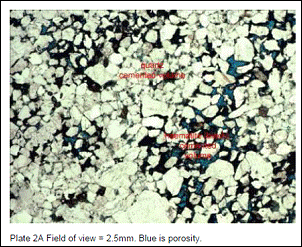 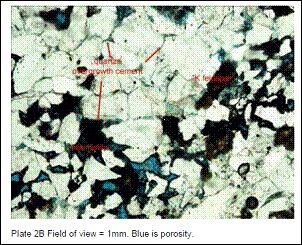
Client: AMS No-Dig Limited
|
Geotechnical Consultancy for Trenchless Construction as part of the West Coast Mainline Route Modernisation (Staffordshire)
Multiple trenchless constructions in the form of guided auger bores were required as part of the West Coast Mainline Route Modernisation works. Perco Engineering Services Limited were commissioned to install the utilities with A F Howland Assocaites acting as their Geotechnical Consultant. AFHA provided advice upon suitable rock strata to bore through and at which depth to achieve a safe and cost efficient construction. This included carrying out exploratory holes either side of the rail tracks to identify the geology and production of a predictive settlement analysis for guided auger boring through various rock strata. All auger bores were successfully completed without hindrance of unexpected geology or excessive surface settlement.


Client: Perco Engineering Services Limited
|
Realignment of the B1039 Royston Road, Chrishall, Essex
It was proposed to realign the B1039 Royston Road to minimise effective loadings from traffic which were thought to be causing failure of an adjacent retaining wall. (Chrishall Retaining Wall, Essex County Council Bridge No.2975). The retaining wall supported a section of the road above an adjacent stream
An investigation was carried out to provide information on the ground conditions expected to be encountered during the road realignment away from the stream. The investigation utilised tracked window sampling equipment with road pavement coring attachment to allow analysis of current pavement construction and dynamic cone penetration testing was utilised to allow design CBR values to be formulated so that subgrade surface modulus stiffness could be calculated and the new road pavement designed.
Client: VolkerFitzpatrick Limited
|
£28 million 4.5 km foul sewer emplacement, Clacton
Longstanding clients Anglian Water Services Limited were required to emplace a foul water flood relief tunnel along Clacton sea front. Complex geotechnical problems associated with the stability of the town’s London Clay cliffs. The initial SI, comprising 150 cable percussive boreholes most with piezometers, indicated that construction of the 2.1 m wide tunnel may cause slope failure of the cliffs and that a channel scour, a water bearing granular deposit, was also present along the proposed route. In addition to the engineering problems identified by AFHA, increasingly hostile opposition by the Clacton residents meant that further analysis was required to enable Anglian Water to prove beyond reasonable doubt that the tunnel would not compromise stability of the cliff. The analysis carried out by AFHA indicated that slope failure of the cliffs was inevitable but that it was in no way affected by the presence of the tunnel. Subsequently, AFHA was able to assure Anglian Water and local residents that the tunnel could safely be constructed below the toe of the cliffs.
The geotechnical analysis also incorporated a comprehensive settlement analysis to enable Anglian Water to refute any compensation claims associated with movement of structures. A survey of adjacent and nearby structures was carried out to allow a rapid response to allegations against the works had the cliffs failed.
Extensive instrumentation was installed to show that the tunnel construction was not affecting cliff stability. Some 140, inclinometers, 70 poneumatic piezometers, and 450 crack gauges were utilised before, during and after in a long term monitoring exercise. |
Subsidence Investigation, Norwich
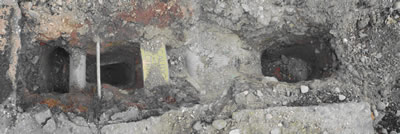
A number of services were encountered during trial pitting
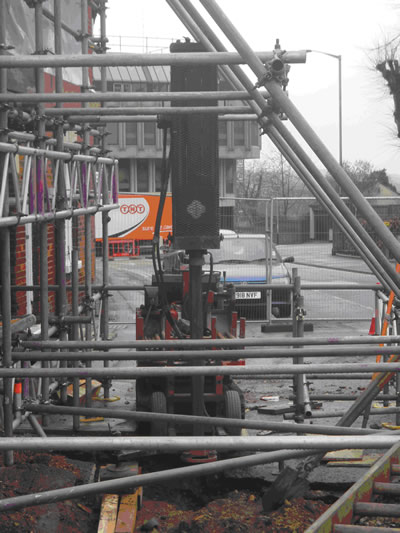
The window sample / dynamic probe rig inside the scaffolding.
On Christmas Eve in 2010 a house in Finklegate, Norwich started to show signs of subsidence. It was estimated that about 300 mm of movement had occurred. Our Client, Consulting Engineers Canham Consulting were employed to investigate the cause of the subsidence and design mitigation work. A F Howland Associates were requested to carry out a site investigation to establish the vertical and lateral extent of any loose soils thought to have been caused by ruptured underground services. The investigation was carried out using our dual purpose window sample / dynamic probe rig together with conventional hand digging tools. The techniques employed were hampered by the presence of numerous underground services and the scaffolding erected to stabilise the property. A F Howland Associates provided expertise in the interpretation of the soil types present in the vicinity of the property as well as the density of the soils in the area. The property has subsequently been demolished. More information on this contract can be read here |
Foreshore Investigation In Southend-On-Sea Job No: 13.153
A F Howland Associates Limited pride themselves on providing
practical engineering solutions.
This approach was tested to the limit in Southend-On-Sea
where A F Howland Associates were asked to provide information on the ground
conditions at a number of replacement ramps and jetties as part of a maintenance
contract.
The work involved a number of near and offshore
investigations. Working with the
tides was essential to ensure a safe system of work for our personnel and
provide relevant information for design of the works for our client whilst
ensuring a cost effective approach.
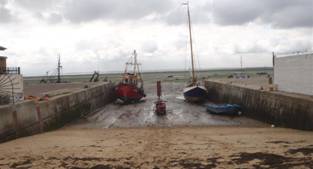 The windowless sampling rig working on one of the slipways
The windowless sampling rig working on one of the slipways
A series of window sample holes and dynamic probes were carried out to confirm the thickness of the superficial Tidal Flat Deposits and
confirm the depth to the more competent London Clay Formation. This was required to allow suitable
design of piled foundations of the replacement structures. The exploratory holes were carried
out utilising our tracked windowless sampling rig which is a relatively
lightweight flexible piece of equipment, ideal for obtaining quick relevant soil
parameters when there is limited time on-site.
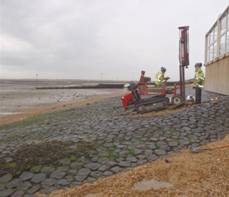 Dynamic probing through the foreshore
Dynamic probing through the foreshore
Our highly trained and competent operatives along with our
supervising engineer ensured that the work was carried out efficiently and more
importantly safely much to the pleasure of the Client.
Various working platforms were constructed and utilised to
ensure the positions were located at the most opportune locations enabling a
safe working environment and minimal disturbance to the local environment.
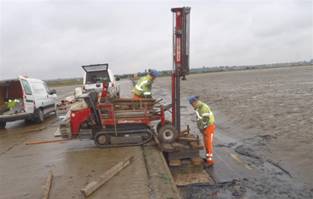 A temporary working platform next to one of the mud flats A temporary working platform next to one of the mud flats
|
| |
|
|
Call 01603 250754 or click here to send an enquiry by email
|

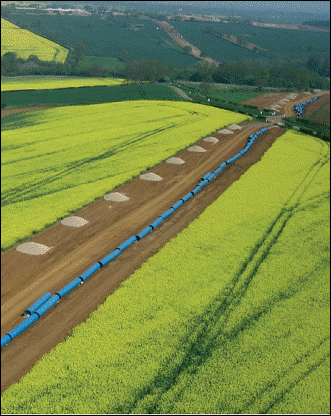
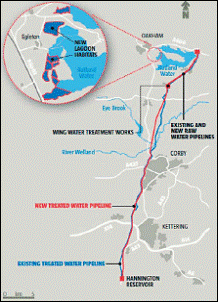






 The windowless sampling rig working on one of the slipways
The windowless sampling rig working on one of the slipways Dynamic probing through the foreshore
Dynamic probing through the foreshore A temporary working platform next to one of the mud flats
A temporary working platform next to one of the mud flats